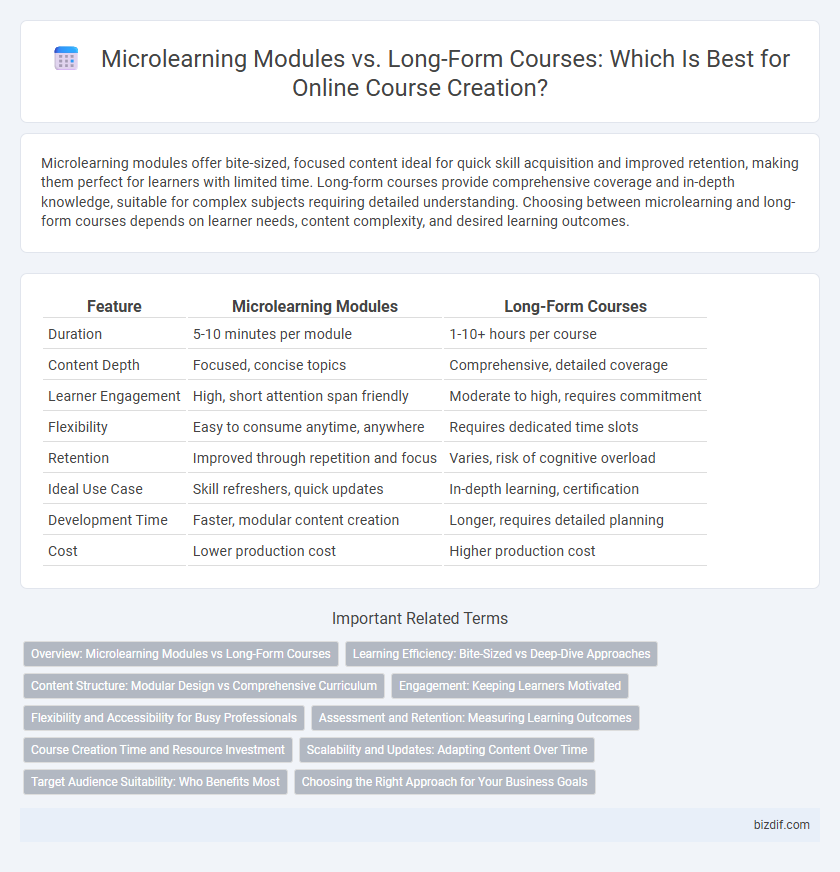Microlearning modules offer bite-sized, focused content ideal for quick skill acquisition and improved retention, making them perfect for learners with limited time. Long-form courses provide comprehensive coverage and in-depth knowledge, suitable for complex subjects requiring detailed understanding. Choosing between microlearning and long-form courses depends on learner needs, content complexity, and desired learning outcomes.
Table of Comparison
| Feature | Microlearning Modules | Long-Form Courses |
|---|---|---|
| Duration | 5-10 minutes per module | 1-10+ hours per course |
| Content Depth | Focused, concise topics | Comprehensive, detailed coverage |
| Learner Engagement | High, short attention span friendly | Moderate to high, requires commitment |
| Flexibility | Easy to consume anytime, anywhere | Requires dedicated time slots |
| Retention | Improved through repetition and focus | Varies, risk of cognitive overload |
| Ideal Use Case | Skill refreshers, quick updates | In-depth learning, certification |
| Development Time | Faster, modular content creation | Longer, requires detailed planning |
| Cost | Lower production cost | Higher production cost |
Overview: Microlearning Modules vs Long-Form Courses
Microlearning modules break content into concise, focused segments typically lasting 5-10 minutes, enhancing retention and learner engagement through targeted knowledge delivery. Long-form courses offer comprehensive, in-depth coverage over extended periods, suitable for complex subjects requiring detailed understanding and skill mastery. Selecting between formats depends on learning objectives, audience preferences, and content complexity to optimize knowledge assimilation and training effectiveness.
Learning Efficiency: Bite-Sized vs Deep-Dive Approaches
Microlearning modules enhance learning efficiency by delivering bite-sized content tailored for quick understanding and retention, ideal for busy learners seeking targeted knowledge. Long-form courses offer deep-dive approaches that promote comprehensive mastery, suitable for complex subjects requiring detailed exploration. Both formats optimize learning outcomes by aligning educational depth with learners' time availability and cognitive capacity.
Content Structure: Modular Design vs Comprehensive Curriculum
Microlearning modules employ a modular design that breaks content into focused, easily digestible segments, enabling learners to grasp specific skills quickly and efficiently. In contrast, long-form courses utilize a comprehensive curriculum that offers in-depth coverage of a subject, facilitating a deeper understanding and mastery over time. Choosing between modular design and comprehensive curriculum depends on learning objectives, learner preferences, and the complexity of the topic.
Engagement: Keeping Learners Motivated
Microlearning modules boost engagement by delivering bite-sized, focused content that fits learners' busy schedules, increasing motivation through quick wins and instant application. Long-form courses provide comprehensive, immersive experiences ideal for deep understanding but risk learner fatigue due to extended duration. Optimizing learner motivation involves balancing concise, interactive microlearning with occasional in-depth sessions to maintain sustained interest and knowledge retention.
Flexibility and Accessibility for Busy Professionals
Microlearning modules offer unparalleled flexibility and accessibility for busy professionals by delivering concise, focused content that can be consumed in short time frames, fitting seamlessly into hectic schedules. Long-form courses typically require extended periods of dedicated attention, which can be challenging for those balancing work and personal commitments. Prioritizing microlearning enables learners to access essential skills quickly, promoting continuous education without overwhelming time constraints.
Assessment and Retention: Measuring Learning Outcomes
Microlearning modules boost retention through frequent, focused assessments that reinforce key concepts and provide immediate feedback, enhancing learner engagement and long-term recall. Long-form courses offer comprehensive evaluations that assess complex understanding and application over extended periods but may risk lower retention due to cognitive overload. Effective measurement of learning outcomes requires aligning assessment types with course format to optimize knowledge retention and skill mastery.
Course Creation Time and Resource Investment
Microlearning modules require significantly less course creation time, often taking days to develop compared to weeks or months for long-form courses, allowing faster deployment and iteration. The resource investment is lower for microlearning, with fewer multimedia elements and shorter content length reducing costs related to scripting, filming, and editing. Long-form courses demand extensive research, multi-session lesson planning, and comprehensive production efforts, resulting in higher financial and human resource commitments.
Scalability and Updates: Adapting Content Over Time
Microlearning modules offer superior scalability by allowing creators to easily update and expand individual content units without overhauling an entire curriculum, ensuring timely adaptation to evolving industry trends. Long-form courses often require extensive revisions and higher resource investment to maintain relevance, making rapid content updates more challenging. Leveraging microlearning supports continuous learning and agile course management, enhancing long-term learner engagement and course lifespan.
Target Audience Suitability: Who Benefits Most
Microlearning modules are ideal for busy professionals and learners seeking quick, focused knowledge bursts that fit into tight schedules, enhancing retention and application. Long-form courses suit in-depth learners aiming for comprehensive understanding and skill mastery, often required in academic or specialized professional settings. Choosing the format depends heavily on learner preferences, time availability, and specific educational goals, ensuring optimal engagement and outcomes.
Choosing the Right Approach for Your Business Goals
Microlearning modules offer targeted, easily digestible content that enhances learner retention and suits time-constrained audiences, increasing course completion rates by up to 80%. Long-form courses provide comprehensive coverage ideal for in-depth skill development and complex subject mastery, supporting businesses aiming for extensive training outcomes. Selecting between microlearning and long-form formats depends on specific business goals such as scalability, learner engagement, and content complexity.
Microlearning modules vs Long-form courses Infographic

 bizdif.com
bizdif.com